Promoting Mental Health and Well-being: Interventions for Adults
VerifiedAdded on 2022/11/23
|14
|4345
|200
AI Summary
This report discusses interventions to improve the mental health and well-being of adults. It includes a critique of interventions, the national mental health and well-being policy in England, risk and protective factors, and the Five Ways to Well-being framework. The report also covers primary and secondary interventions, advantages and difficulties of interventions, and evaluation of interventions.
Contribute Materials
Your contribution can guide someone’s learning journey. Share your
documents today.
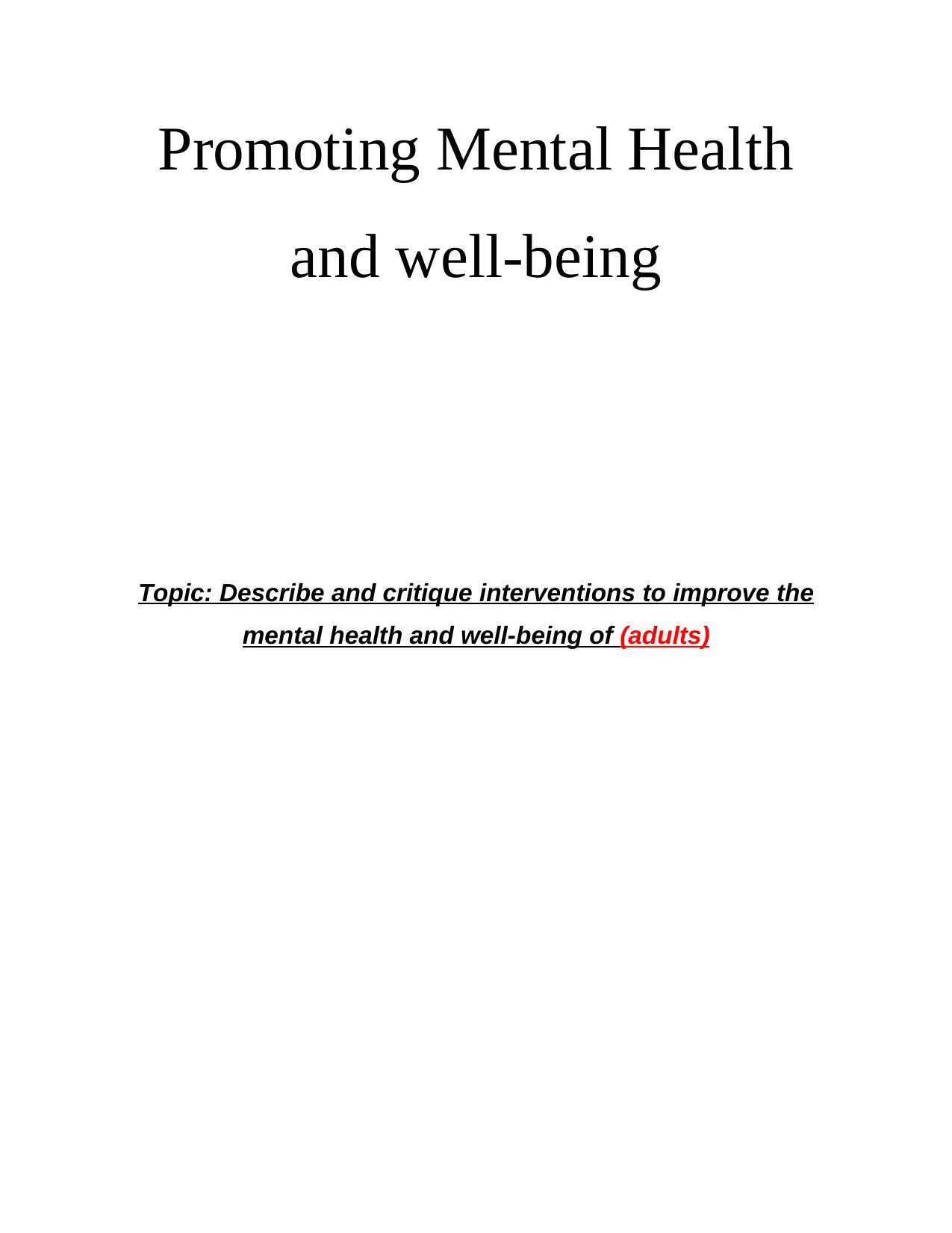
Promoting Mental Health
and well-being
Topic: Describe and critique interventions to improve the
mental health and well-being of (adults)
and well-being
Topic: Describe and critique interventions to improve the
mental health and well-being of (adults)
Secure Best Marks with AI Grader
Need help grading? Try our AI Grader for instant feedback on your assignments.
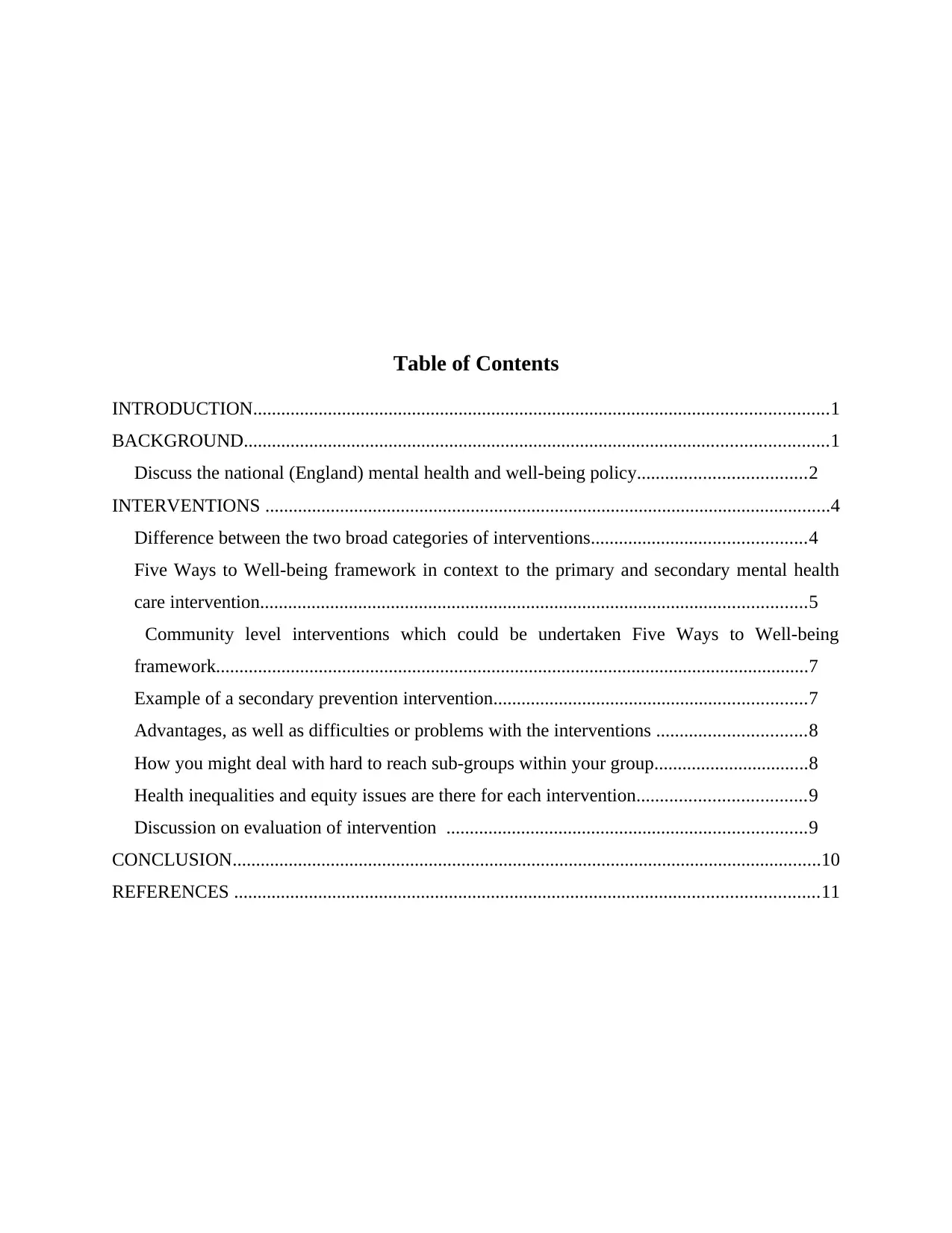
Table of Contents
INTRODUCTION...........................................................................................................................1
BACKGROUND.............................................................................................................................1
Discuss the national (England) mental health and well-being policy....................................2
INTERVENTIONS .........................................................................................................................4
Difference between the two broad categories of interventions..............................................4
Five Ways to Well-being framework in context to the primary and secondary mental health
care intervention.....................................................................................................................5
Community level interventions which could be undertaken Five Ways to Well-being
framework...............................................................................................................................7
Example of a secondary prevention intervention...................................................................7
Advantages, as well as difficulties or problems with the interventions ................................8
How you might deal with hard to reach sub-groups within your group.................................8
Health inequalities and equity issues are there for each intervention....................................9
Discussion on evaluation of intervention .............................................................................9
CONCLUSION..............................................................................................................................10
REFERENCES .............................................................................................................................11
INTRODUCTION...........................................................................................................................1
BACKGROUND.............................................................................................................................1
Discuss the national (England) mental health and well-being policy....................................2
INTERVENTIONS .........................................................................................................................4
Difference between the two broad categories of interventions..............................................4
Five Ways to Well-being framework in context to the primary and secondary mental health
care intervention.....................................................................................................................5
Community level interventions which could be undertaken Five Ways to Well-being
framework...............................................................................................................................7
Example of a secondary prevention intervention...................................................................7
Advantages, as well as difficulties or problems with the interventions ................................8
How you might deal with hard to reach sub-groups within your group.................................8
Health inequalities and equity issues are there for each intervention....................................9
Discussion on evaluation of intervention .............................................................................9
CONCLUSION..............................................................................................................................10
REFERENCES .............................................................................................................................11

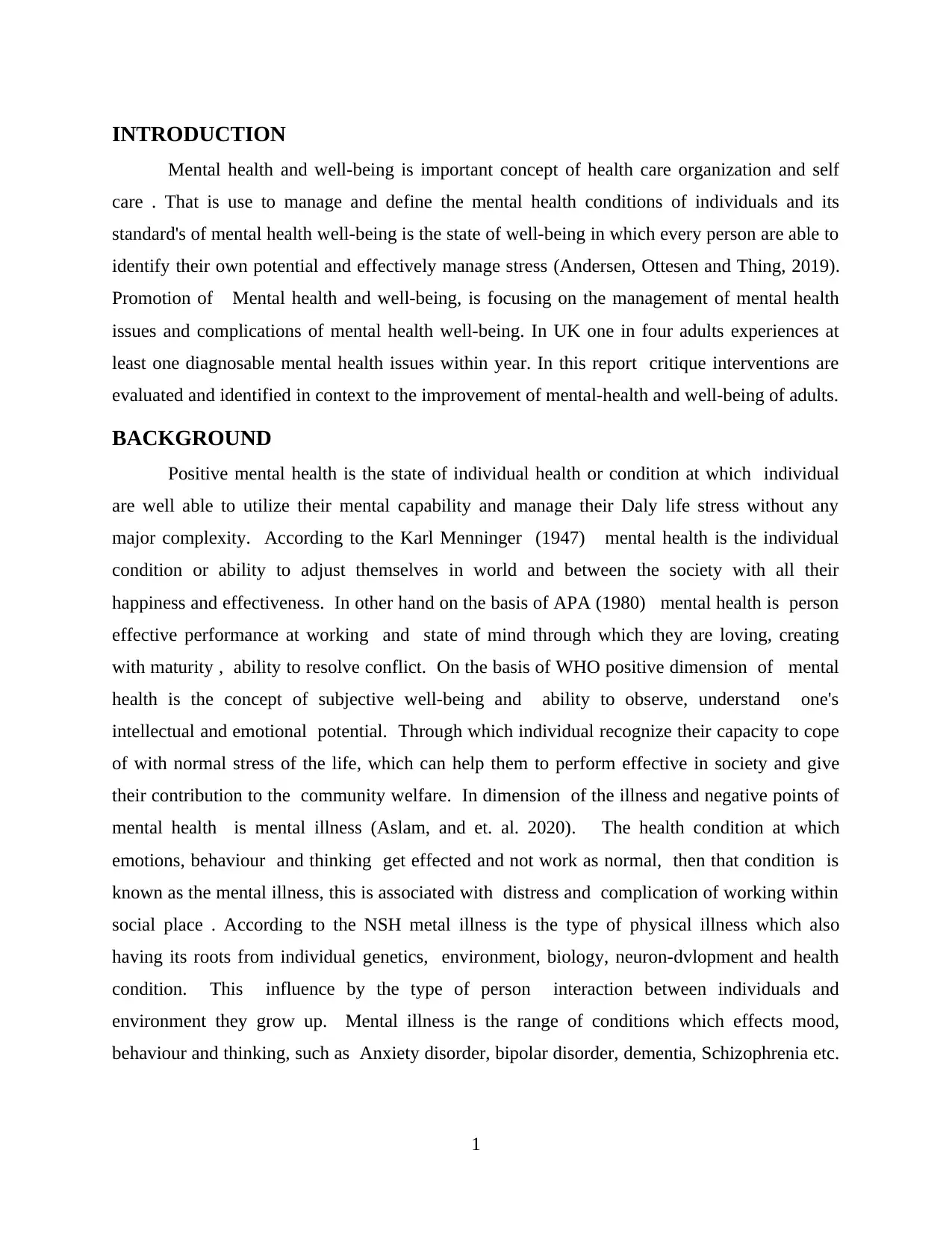
INTRODUCTION
Mental health and well-being is important concept of health care organization and self
care . That is use to manage and define the mental health conditions of individuals and its
standard's of mental health well-being is the state of well-being in which every person are able to
identify their own potential and effectively manage stress (Andersen, Ottesen and Thing, 2019).
Promotion of Mental health and well-being, is focusing on the management of mental health
issues and complications of mental health well-being. In UK one in four adults experiences at
least one diagnosable mental health issues within year. In this report critique interventions are
evaluated and identified in context to the improvement of mental-health and well-being of adults.
BACKGROUND
Positive mental health is the state of individual health or condition at which individual
are well able to utilize their mental capability and manage their Daly life stress without any
major complexity. According to the Karl Menninger (1947) mental health is the individual
condition or ability to adjust themselves in world and between the society with all their
happiness and effectiveness. In other hand on the basis of APA (1980) mental health is person
effective performance at working and state of mind through which they are loving, creating
with maturity , ability to resolve conflict. On the basis of WHO positive dimension of mental
health is the concept of subjective well-being and ability to observe, understand one's
intellectual and emotional potential. Through which individual recognize their capacity to cope
of with normal stress of the life, which can help them to perform effective in society and give
their contribution to the community welfare. In dimension of the illness and negative points of
mental health is mental illness (Aslam, and et. al. 2020). The health condition at which
emotions, behaviour and thinking get effected and not work as normal, then that condition is
known as the mental illness, this is associated with distress and complication of working within
social place . According to the NSH metal illness is the type of physical illness which also
having its roots from individual genetics, environment, biology, neuron-dvlopment and health
condition. This influence by the type of person interaction between individuals and
environment they grow up. Mental illness is the range of conditions which effects mood,
behaviour and thinking, such as Anxiety disorder, bipolar disorder, dementia, Schizophrenia etc.
1
Mental health and well-being is important concept of health care organization and self
care . That is use to manage and define the mental health conditions of individuals and its
standard's of mental health well-being is the state of well-being in which every person are able to
identify their own potential and effectively manage stress (Andersen, Ottesen and Thing, 2019).
Promotion of Mental health and well-being, is focusing on the management of mental health
issues and complications of mental health well-being. In UK one in four adults experiences at
least one diagnosable mental health issues within year. In this report critique interventions are
evaluated and identified in context to the improvement of mental-health and well-being of adults.
BACKGROUND
Positive mental health is the state of individual health or condition at which individual
are well able to utilize their mental capability and manage their Daly life stress without any
major complexity. According to the Karl Menninger (1947) mental health is the individual
condition or ability to adjust themselves in world and between the society with all their
happiness and effectiveness. In other hand on the basis of APA (1980) mental health is person
effective performance at working and state of mind through which they are loving, creating
with maturity , ability to resolve conflict. On the basis of WHO positive dimension of mental
health is the concept of subjective well-being and ability to observe, understand one's
intellectual and emotional potential. Through which individual recognize their capacity to cope
of with normal stress of the life, which can help them to perform effective in society and give
their contribution to the community welfare. In dimension of the illness and negative points of
mental health is mental illness (Aslam, and et. al. 2020). The health condition at which
emotions, behaviour and thinking get effected and not work as normal, then that condition is
known as the mental illness, this is associated with distress and complication of working within
social place . According to the NSH metal illness is the type of physical illness which also
having its roots from individual genetics, environment, biology, neuron-dvlopment and health
condition. This influence by the type of person interaction between individuals and
environment they grow up. Mental illness is the range of conditions which effects mood,
behaviour and thinking, such as Anxiety disorder, bipolar disorder, dementia, Schizophrenia etc.
1
Secure Best Marks with AI Grader
Need help grading? Try our AI Grader for instant feedback on your assignments.
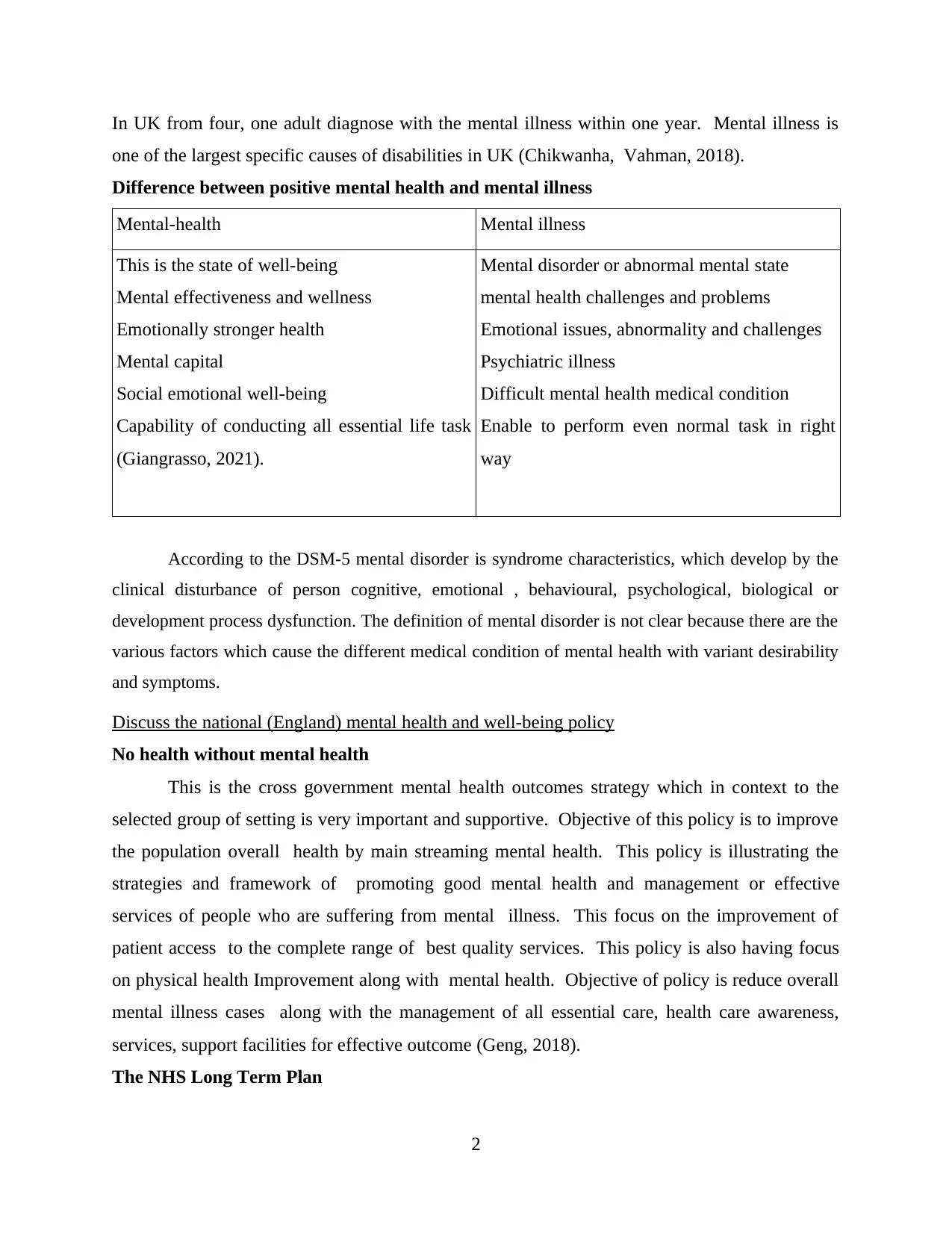
In UK from four, one adult diagnose with the mental illness within one year. Mental illness is
one of the largest specific causes of disabilities in UK (Chikwanha, Vahman, 2018).
Difference between positive mental health and mental illness
Mental-health Mental illness
This is the state of well-being
Mental effectiveness and wellness
Emotionally stronger health
Mental capital
Social emotional well-being
Capability of conducting all essential life task
(Giangrasso, 2021).
Mental disorder or abnormal mental state
mental health challenges and problems
Emotional issues, abnormality and challenges
Psychiatric illness
Difficult mental health medical condition
Enable to perform even normal task in right
way
According to the DSM-5 mental disorder is syndrome characteristics, which develop by the
clinical disturbance of person cognitive, emotional , behavioural, psychological, biological or
development process dysfunction. The definition of mental disorder is not clear because there are the
various factors which cause the different medical condition of mental health with variant desirability
and symptoms.
Discuss the national (England) mental health and well-being policy
No health without mental health
This is the cross government mental health outcomes strategy which in context to the
selected group of setting is very important and supportive. Objective of this policy is to improve
the population overall health by main streaming mental health. This policy is illustrating the
strategies and framework of promoting good mental health and management or effective
services of people who are suffering from mental illness. This focus on the improvement of
patient access to the complete range of best quality services. This policy is also having focus
on physical health Improvement along with mental health. Objective of policy is reduce overall
mental illness cases along with the management of all essential care, health care awareness,
services, support facilities for effective outcome (Geng, 2018).
The NHS Long Term Plan
2
one of the largest specific causes of disabilities in UK (Chikwanha, Vahman, 2018).
Difference between positive mental health and mental illness
Mental-health Mental illness
This is the state of well-being
Mental effectiveness and wellness
Emotionally stronger health
Mental capital
Social emotional well-being
Capability of conducting all essential life task
(Giangrasso, 2021).
Mental disorder or abnormal mental state
mental health challenges and problems
Emotional issues, abnormality and challenges
Psychiatric illness
Difficult mental health medical condition
Enable to perform even normal task in right
way
According to the DSM-5 mental disorder is syndrome characteristics, which develop by the
clinical disturbance of person cognitive, emotional , behavioural, psychological, biological or
development process dysfunction. The definition of mental disorder is not clear because there are the
various factors which cause the different medical condition of mental health with variant desirability
and symptoms.
Discuss the national (England) mental health and well-being policy
No health without mental health
This is the cross government mental health outcomes strategy which in context to the
selected group of setting is very important and supportive. Objective of this policy is to improve
the population overall health by main streaming mental health. This policy is illustrating the
strategies and framework of promoting good mental health and management or effective
services of people who are suffering from mental illness. This focus on the improvement of
patient access to the complete range of best quality services. This policy is also having focus
on physical health Improvement along with mental health. Objective of policy is reduce overall
mental illness cases along with the management of all essential care, health care awareness,
services, support facilities for effective outcome (Geng, 2018).
The NHS Long Term Plan
2
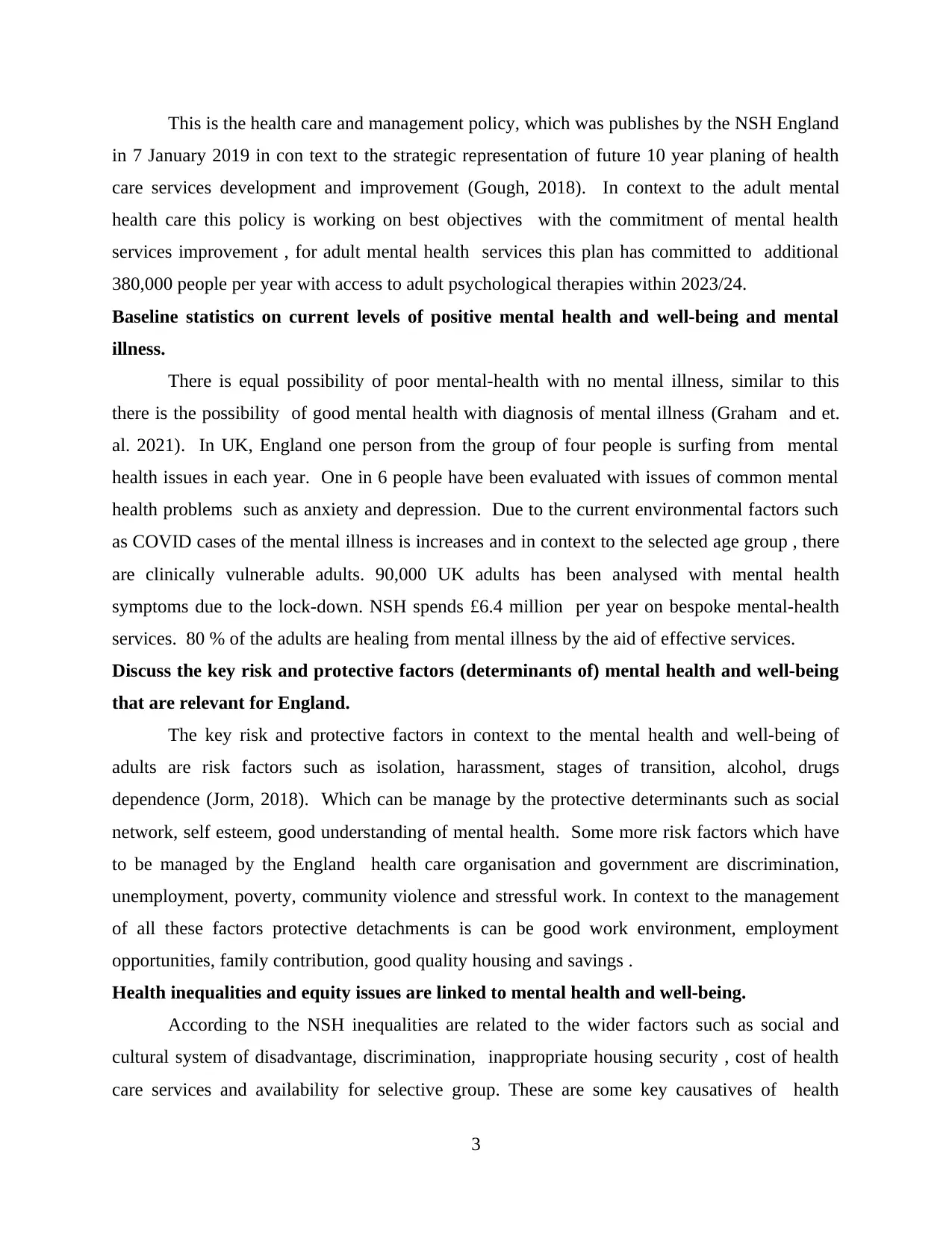
This is the health care and management policy, which was publishes by the NSH England
in 7 January 2019 in con text to the strategic representation of future 10 year planing of health
care services development and improvement (Gough, 2018). In context to the adult mental
health care this policy is working on best objectives with the commitment of mental health
services improvement , for adult mental health services this plan has committed to additional
380,000 people per year with access to adult psychological therapies within 2023/24.
Baseline statistics on current levels of positive mental health and well-being and mental
illness.
There is equal possibility of poor mental-health with no mental illness, similar to this
there is the possibility of good mental health with diagnosis of mental illness (Graham and et.
al. 2021). In UK, England one person from the group of four people is surfing from mental
health issues in each year. One in 6 people have been evaluated with issues of common mental
health problems such as anxiety and depression. Due to the current environmental factors such
as COVID cases of the mental illness is increases and in context to the selected age group , there
are clinically vulnerable adults. 90,000 UK adults has been analysed with mental health
symptoms due to the lock-down. NSH spends £6.4 million per year on bespoke mental-health
services. 80 % of the adults are healing from mental illness by the aid of effective services.
Discuss the key risk and protective factors (determinants of) mental health and well-being
that are relevant for England.
The key risk and protective factors in context to the mental health and well-being of
adults are risk factors such as isolation, harassment, stages of transition, alcohol, drugs
dependence (Jorm, 2018). Which can be manage by the protective determinants such as social
network, self esteem, good understanding of mental health. Some more risk factors which have
to be managed by the England health care organisation and government are discrimination,
unemployment, poverty, community violence and stressful work. In context to the management
of all these factors protective detachments is can be good work environment, employment
opportunities, family contribution, good quality housing and savings .
Health inequalities and equity issues are linked to mental health and well-being.
According to the NSH inequalities are related to the wider factors such as social and
cultural system of disadvantage, discrimination, inappropriate housing security , cost of health
care services and availability for selective group. These are some key causatives of health
3
in 7 January 2019 in con text to the strategic representation of future 10 year planing of health
care services development and improvement (Gough, 2018). In context to the adult mental
health care this policy is working on best objectives with the commitment of mental health
services improvement , for adult mental health services this plan has committed to additional
380,000 people per year with access to adult psychological therapies within 2023/24.
Baseline statistics on current levels of positive mental health and well-being and mental
illness.
There is equal possibility of poor mental-health with no mental illness, similar to this
there is the possibility of good mental health with diagnosis of mental illness (Graham and et.
al. 2021). In UK, England one person from the group of four people is surfing from mental
health issues in each year. One in 6 people have been evaluated with issues of common mental
health problems such as anxiety and depression. Due to the current environmental factors such
as COVID cases of the mental illness is increases and in context to the selected age group , there
are clinically vulnerable adults. 90,000 UK adults has been analysed with mental health
symptoms due to the lock-down. NSH spends £6.4 million per year on bespoke mental-health
services. 80 % of the adults are healing from mental illness by the aid of effective services.
Discuss the key risk and protective factors (determinants of) mental health and well-being
that are relevant for England.
The key risk and protective factors in context to the mental health and well-being of
adults are risk factors such as isolation, harassment, stages of transition, alcohol, drugs
dependence (Jorm, 2018). Which can be manage by the protective determinants such as social
network, self esteem, good understanding of mental health. Some more risk factors which have
to be managed by the England health care organisation and government are discrimination,
unemployment, poverty, community violence and stressful work. In context to the management
of all these factors protective detachments is can be good work environment, employment
opportunities, family contribution, good quality housing and savings .
Health inequalities and equity issues are linked to mental health and well-being.
According to the NSH inequalities are related to the wider factors such as social and
cultural system of disadvantage, discrimination, inappropriate housing security , cost of health
care services and availability for selective group. These are some key causatives of health
3
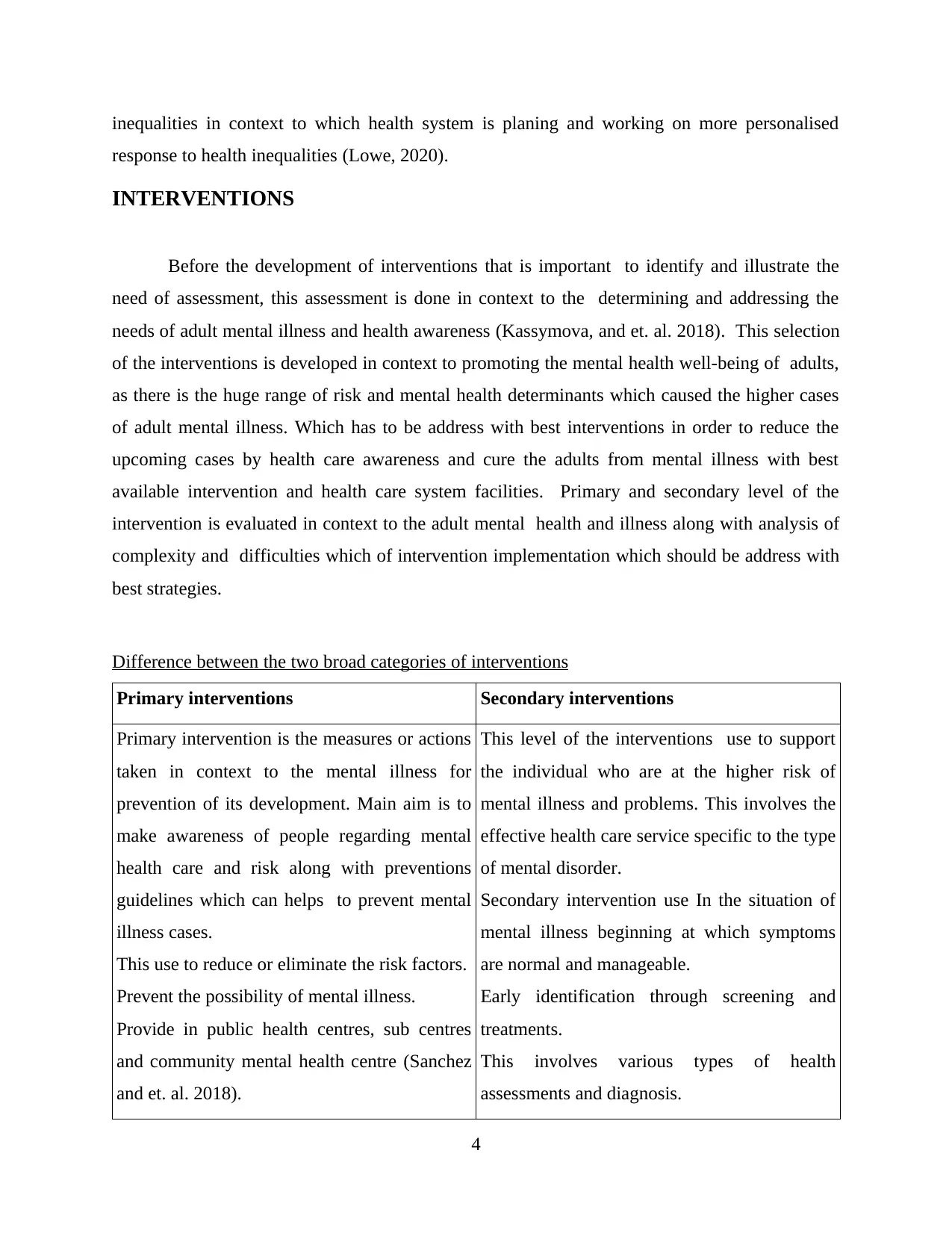
inequalities in context to which health system is planing and working on more personalised
response to health inequalities (Lowe, 2020).
INTERVENTIONS
Before the development of interventions that is important to identify and illustrate the
need of assessment, this assessment is done in context to the determining and addressing the
needs of adult mental illness and health awareness (Kassymova, and et. al. 2018). This selection
of the interventions is developed in context to promoting the mental health well-being of adults,
as there is the huge range of risk and mental health determinants which caused the higher cases
of adult mental illness. Which has to be address with best interventions in order to reduce the
upcoming cases by health care awareness and cure the adults from mental illness with best
available intervention and health care system facilities. Primary and secondary level of the
intervention is evaluated in context to the adult mental health and illness along with analysis of
complexity and difficulties which of intervention implementation which should be address with
best strategies.
Difference between the two broad categories of interventions
Primary interventions Secondary interventions
Primary intervention is the measures or actions
taken in context to the mental illness for
prevention of its development. Main aim is to
make awareness of people regarding mental
health care and risk along with preventions
guidelines which can helps to prevent mental
illness cases.
This use to reduce or eliminate the risk factors.
Prevent the possibility of mental illness.
Provide in public health centres, sub centres
and community mental health centre (Sanchez
and et. al. 2018).
This level of the interventions use to support
the individual who are at the higher risk of
mental illness and problems. This involves the
effective health care service specific to the type
of mental disorder.
Secondary intervention use In the situation of
mental illness beginning at which symptoms
are normal and manageable.
Early identification through screening and
treatments.
This involves various types of health
assessments and diagnosis.
4
response to health inequalities (Lowe, 2020).
INTERVENTIONS
Before the development of interventions that is important to identify and illustrate the
need of assessment, this assessment is done in context to the determining and addressing the
needs of adult mental illness and health awareness (Kassymova, and et. al. 2018). This selection
of the interventions is developed in context to promoting the mental health well-being of adults,
as there is the huge range of risk and mental health determinants which caused the higher cases
of adult mental illness. Which has to be address with best interventions in order to reduce the
upcoming cases by health care awareness and cure the adults from mental illness with best
available intervention and health care system facilities. Primary and secondary level of the
intervention is evaluated in context to the adult mental health and illness along with analysis of
complexity and difficulties which of intervention implementation which should be address with
best strategies.
Difference between the two broad categories of interventions
Primary interventions Secondary interventions
Primary intervention is the measures or actions
taken in context to the mental illness for
prevention of its development. Main aim is to
make awareness of people regarding mental
health care and risk along with preventions
guidelines which can helps to prevent mental
illness cases.
This use to reduce or eliminate the risk factors.
Prevent the possibility of mental illness.
Provide in public health centres, sub centres
and community mental health centre (Sanchez
and et. al. 2018).
This level of the interventions use to support
the individual who are at the higher risk of
mental illness and problems. This involves the
effective health care service specific to the type
of mental disorder.
Secondary intervention use In the situation of
mental illness beginning at which symptoms
are normal and manageable.
Early identification through screening and
treatments.
This involves various types of health
assessments and diagnosis.
4
Paraphrase This Document
Need a fresh take? Get an instant paraphrase of this document with our AI Paraphraser
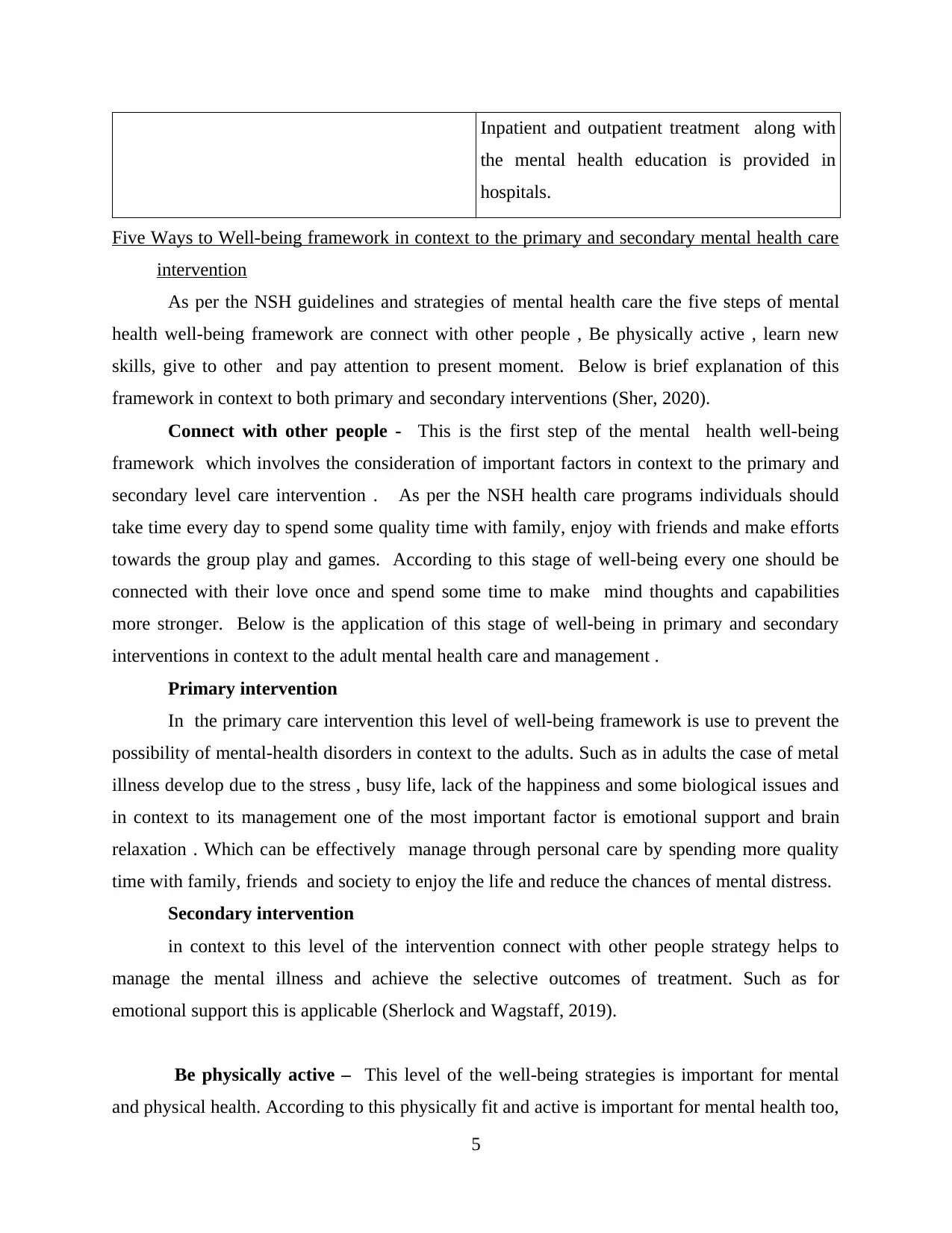
Inpatient and outpatient treatment along with
the mental health education is provided in
hospitals.
Five Ways to Well-being framework in context to the primary and secondary mental health care
intervention
As per the NSH guidelines and strategies of mental health care the five steps of mental
health well-being framework are connect with other people , Be physically active , learn new
skills, give to other and pay attention to present moment. Below is brief explanation of this
framework in context to both primary and secondary interventions (Sher, 2020).
Connect with other people - This is the first step of the mental health well-being
framework which involves the consideration of important factors in context to the primary and
secondary level care intervention . As per the NSH health care programs individuals should
take time every day to spend some quality time with family, enjoy with friends and make efforts
towards the group play and games. According to this stage of well-being every one should be
connected with their love once and spend some time to make mind thoughts and capabilities
more stronger. Below is the application of this stage of well-being in primary and secondary
interventions in context to the adult mental health care and management .
Primary intervention
In the primary care intervention this level of well-being framework is use to prevent the
possibility of mental-health disorders in context to the adults. Such as in adults the case of metal
illness develop due to the stress , busy life, lack of the happiness and some biological issues and
in context to its management one of the most important factor is emotional support and brain
relaxation . Which can be effectively manage through personal care by spending more quality
time with family, friends and society to enjoy the life and reduce the chances of mental distress.
Secondary intervention
in context to this level of the intervention connect with other people strategy helps to
manage the mental illness and achieve the selective outcomes of treatment. Such as for
emotional support this is applicable (Sherlock and Wagstaff, 2019).
Be physically active – This level of the well-being strategies is important for mental
and physical health. According to this physically fit and active is important for mental health too,
5
the mental health education is provided in
hospitals.
Five Ways to Well-being framework in context to the primary and secondary mental health care
intervention
As per the NSH guidelines and strategies of mental health care the five steps of mental
health well-being framework are connect with other people , Be physically active , learn new
skills, give to other and pay attention to present moment. Below is brief explanation of this
framework in context to both primary and secondary interventions (Sher, 2020).
Connect with other people - This is the first step of the mental health well-being
framework which involves the consideration of important factors in context to the primary and
secondary level care intervention . As per the NSH health care programs individuals should
take time every day to spend some quality time with family, enjoy with friends and make efforts
towards the group play and games. According to this stage of well-being every one should be
connected with their love once and spend some time to make mind thoughts and capabilities
more stronger. Below is the application of this stage of well-being in primary and secondary
interventions in context to the adult mental health care and management .
Primary intervention
In the primary care intervention this level of well-being framework is use to prevent the
possibility of mental-health disorders in context to the adults. Such as in adults the case of metal
illness develop due to the stress , busy life, lack of the happiness and some biological issues and
in context to its management one of the most important factor is emotional support and brain
relaxation . Which can be effectively manage through personal care by spending more quality
time with family, friends and society to enjoy the life and reduce the chances of mental distress.
Secondary intervention
in context to this level of the intervention connect with other people strategy helps to
manage the mental illness and achieve the selective outcomes of treatment. Such as for
emotional support this is applicable (Sherlock and Wagstaff, 2019).
Be physically active – This level of the well-being strategies is important for mental
and physical health. According to this physically fit and active is important for mental health too,
5
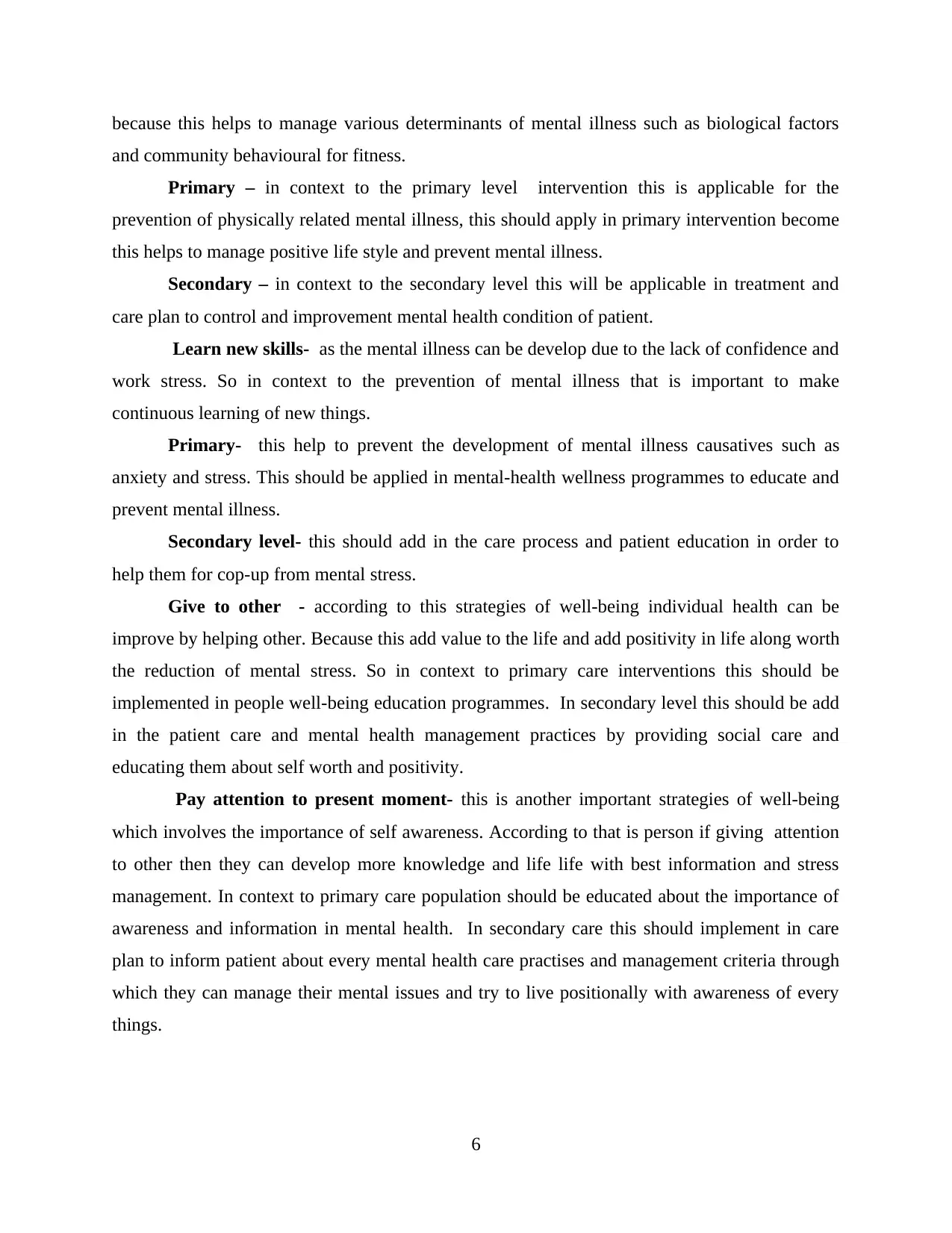
because this helps to manage various determinants of mental illness such as biological factors
and community behavioural for fitness.
Primary – in context to the primary level intervention this is applicable for the
prevention of physically related mental illness, this should apply in primary intervention become
this helps to manage positive life style and prevent mental illness.
Secondary – in context to the secondary level this will be applicable in treatment and
care plan to control and improvement mental health condition of patient.
Learn new skills- as the mental illness can be develop due to the lack of confidence and
work stress. So in context to the prevention of mental illness that is important to make
continuous learning of new things.
Primary- this help to prevent the development of mental illness causatives such as
anxiety and stress. This should be applied in mental-health wellness programmes to educate and
prevent mental illness.
Secondary level- this should add in the care process and patient education in order to
help them for cop-up from mental stress.
Give to other - according to this strategies of well-being individual health can be
improve by helping other. Because this add value to the life and add positivity in life along worth
the reduction of mental stress. So in context to primary care interventions this should be
implemented in people well-being education programmes. In secondary level this should be add
in the patient care and mental health management practices by providing social care and
educating them about self worth and positivity.
Pay attention to present moment- this is another important strategies of well-being
which involves the importance of self awareness. According to that is person if giving attention
to other then they can develop more knowledge and life life with best information and stress
management. In context to primary care population should be educated about the importance of
awareness and information in mental health. In secondary care this should implement in care
plan to inform patient about every mental health care practises and management criteria through
which they can manage their mental issues and try to live positionally with awareness of every
things.
6
and community behavioural for fitness.
Primary – in context to the primary level intervention this is applicable for the
prevention of physically related mental illness, this should apply in primary intervention become
this helps to manage positive life style and prevent mental illness.
Secondary – in context to the secondary level this will be applicable in treatment and
care plan to control and improvement mental health condition of patient.
Learn new skills- as the mental illness can be develop due to the lack of confidence and
work stress. So in context to the prevention of mental illness that is important to make
continuous learning of new things.
Primary- this help to prevent the development of mental illness causatives such as
anxiety and stress. This should be applied in mental-health wellness programmes to educate and
prevent mental illness.
Secondary level- this should add in the care process and patient education in order to
help them for cop-up from mental stress.
Give to other - according to this strategies of well-being individual health can be
improve by helping other. Because this add value to the life and add positivity in life along worth
the reduction of mental stress. So in context to primary care interventions this should be
implemented in people well-being education programmes. In secondary level this should be add
in the patient care and mental health management practices by providing social care and
educating them about self worth and positivity.
Pay attention to present moment- this is another important strategies of well-being
which involves the importance of self awareness. According to that is person if giving attention
to other then they can develop more knowledge and life life with best information and stress
management. In context to primary care population should be educated about the importance of
awareness and information in mental health. In secondary care this should implement in care
plan to inform patient about every mental health care practises and management criteria through
which they can manage their mental issues and try to live positionally with awareness of every
things.
6
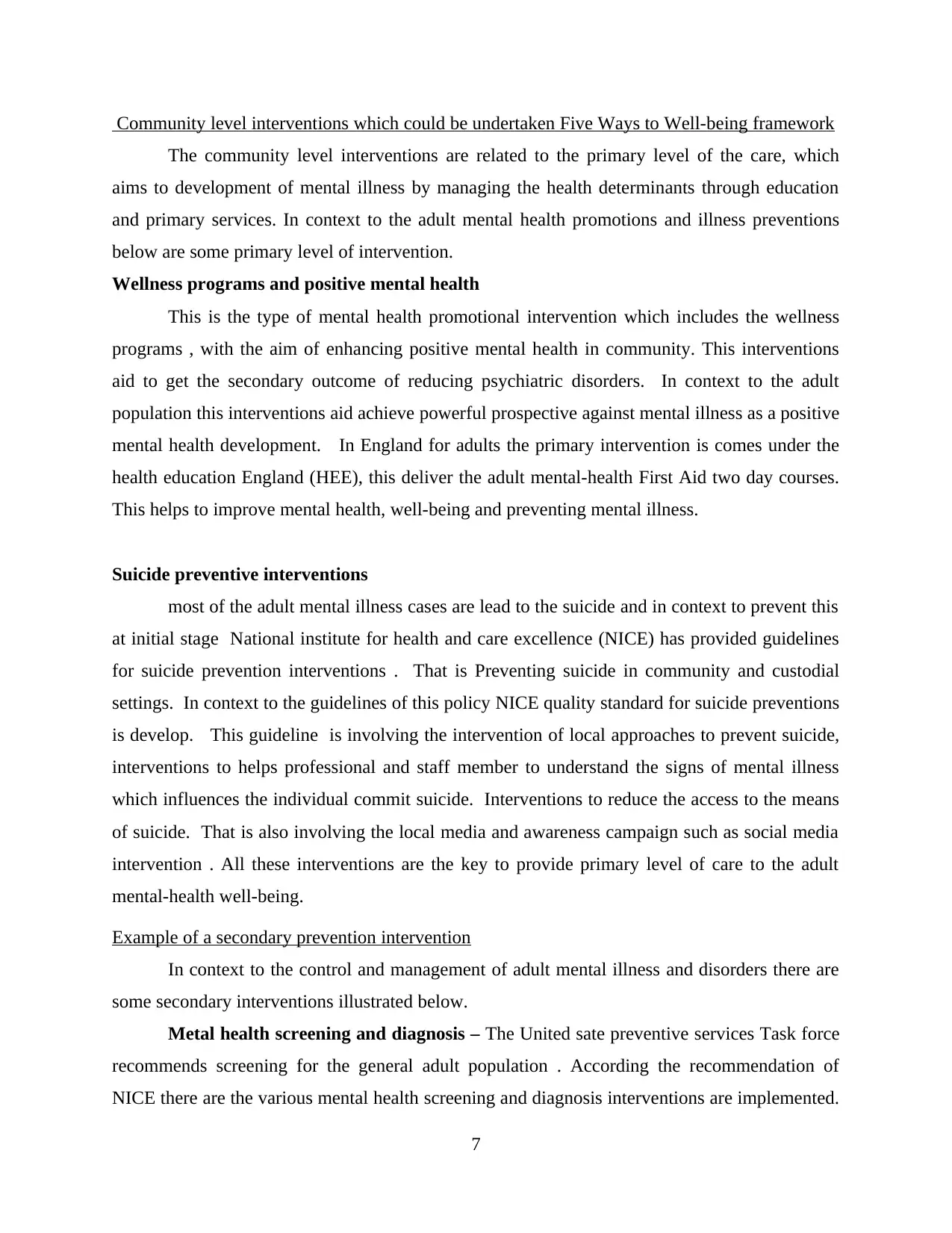
Community level interventions which could be undertaken Five Ways to Well-being framework
The community level interventions are related to the primary level of the care, which
aims to development of mental illness by managing the health determinants through education
and primary services. In context to the adult mental health promotions and illness preventions
below are some primary level of intervention.
Wellness programs and positive mental health
This is the type of mental health promotional intervention which includes the wellness
programs , with the aim of enhancing positive mental health in community. This interventions
aid to get the secondary outcome of reducing psychiatric disorders. In context to the adult
population this interventions aid achieve powerful prospective against mental illness as a positive
mental health development. In England for adults the primary intervention is comes under the
health education England (HEE), this deliver the adult mental-health First Aid two day courses.
This helps to improve mental health, well-being and preventing mental illness.
Suicide preventive interventions
most of the adult mental illness cases are lead to the suicide and in context to prevent this
at initial stage National institute for health and care excellence (NICE) has provided guidelines
for suicide prevention interventions . That is Preventing suicide in community and custodial
settings. In context to the guidelines of this policy NICE quality standard for suicide preventions
is develop. This guideline is involving the intervention of local approaches to prevent suicide,
interventions to helps professional and staff member to understand the signs of mental illness
which influences the individual commit suicide. Interventions to reduce the access to the means
of suicide. That is also involving the local media and awareness campaign such as social media
intervention . All these interventions are the key to provide primary level of care to the adult
mental-health well-being.
Example of a secondary prevention intervention
In context to the control and management of adult mental illness and disorders there are
some secondary interventions illustrated below.
Metal health screening and diagnosis – The United sate preventive services Task force
recommends screening for the general adult population . According the recommendation of
NICE there are the various mental health screening and diagnosis interventions are implemented.
7
The community level interventions are related to the primary level of the care, which
aims to development of mental illness by managing the health determinants through education
and primary services. In context to the adult mental health promotions and illness preventions
below are some primary level of intervention.
Wellness programs and positive mental health
This is the type of mental health promotional intervention which includes the wellness
programs , with the aim of enhancing positive mental health in community. This interventions
aid to get the secondary outcome of reducing psychiatric disorders. In context to the adult
population this interventions aid achieve powerful prospective against mental illness as a positive
mental health development. In England for adults the primary intervention is comes under the
health education England (HEE), this deliver the adult mental-health First Aid two day courses.
This helps to improve mental health, well-being and preventing mental illness.
Suicide preventive interventions
most of the adult mental illness cases are lead to the suicide and in context to prevent this
at initial stage National institute for health and care excellence (NICE) has provided guidelines
for suicide prevention interventions . That is Preventing suicide in community and custodial
settings. In context to the guidelines of this policy NICE quality standard for suicide preventions
is develop. This guideline is involving the intervention of local approaches to prevent suicide,
interventions to helps professional and staff member to understand the signs of mental illness
which influences the individual commit suicide. Interventions to reduce the access to the means
of suicide. That is also involving the local media and awareness campaign such as social media
intervention . All these interventions are the key to provide primary level of care to the adult
mental-health well-being.
Example of a secondary prevention intervention
In context to the control and management of adult mental illness and disorders there are
some secondary interventions illustrated below.
Metal health screening and diagnosis – The United sate preventive services Task force
recommends screening for the general adult population . According the recommendation of
NICE there are the various mental health screening and diagnosis interventions are implemented.
7
Secure Best Marks with AI Grader
Need help grading? Try our AI Grader for instant feedback on your assignments.
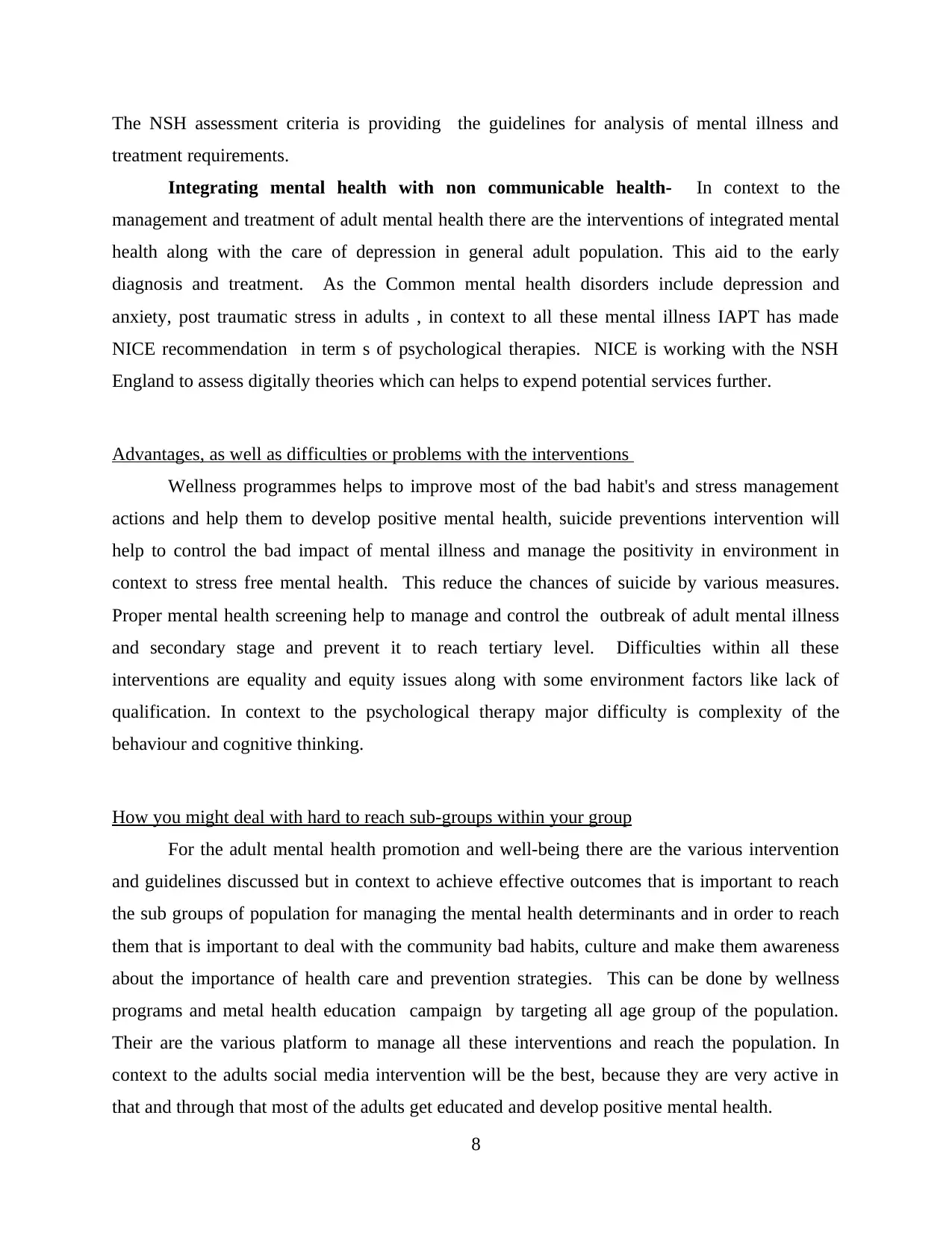
The NSH assessment criteria is providing the guidelines for analysis of mental illness and
treatment requirements.
Integrating mental health with non communicable health- In context to the
management and treatment of adult mental health there are the interventions of integrated mental
health along with the care of depression in general adult population. This aid to the early
diagnosis and treatment. As the Common mental health disorders include depression and
anxiety, post traumatic stress in adults , in context to all these mental illness IAPT has made
NICE recommendation in term s of psychological therapies. NICE is working with the NSH
England to assess digitally theories which can helps to expend potential services further.
Advantages, as well as difficulties or problems with the interventions
Wellness programmes helps to improve most of the bad habit's and stress management
actions and help them to develop positive mental health, suicide preventions intervention will
help to control the bad impact of mental illness and manage the positivity in environment in
context to stress free mental health. This reduce the chances of suicide by various measures.
Proper mental health screening help to manage and control the outbreak of adult mental illness
and secondary stage and prevent it to reach tertiary level. Difficulties within all these
interventions are equality and equity issues along with some environment factors like lack of
qualification. In context to the psychological therapy major difficulty is complexity of the
behaviour and cognitive thinking.
How you might deal with hard to reach sub-groups within your group
For the adult mental health promotion and well-being there are the various intervention
and guidelines discussed but in context to achieve effective outcomes that is important to reach
the sub groups of population for managing the mental health determinants and in order to reach
them that is important to deal with the community bad habits, culture and make them awareness
about the importance of health care and prevention strategies. This can be done by wellness
programs and metal health education campaign by targeting all age group of the population.
Their are the various platform to manage all these interventions and reach the population. In
context to the adults social media intervention will be the best, because they are very active in
that and through that most of the adults get educated and develop positive mental health.
8
treatment requirements.
Integrating mental health with non communicable health- In context to the
management and treatment of adult mental health there are the interventions of integrated mental
health along with the care of depression in general adult population. This aid to the early
diagnosis and treatment. As the Common mental health disorders include depression and
anxiety, post traumatic stress in adults , in context to all these mental illness IAPT has made
NICE recommendation in term s of psychological therapies. NICE is working with the NSH
England to assess digitally theories which can helps to expend potential services further.
Advantages, as well as difficulties or problems with the interventions
Wellness programmes helps to improve most of the bad habit's and stress management
actions and help them to develop positive mental health, suicide preventions intervention will
help to control the bad impact of mental illness and manage the positivity in environment in
context to stress free mental health. This reduce the chances of suicide by various measures.
Proper mental health screening help to manage and control the outbreak of adult mental illness
and secondary stage and prevent it to reach tertiary level. Difficulties within all these
interventions are equality and equity issues along with some environment factors like lack of
qualification. In context to the psychological therapy major difficulty is complexity of the
behaviour and cognitive thinking.
How you might deal with hard to reach sub-groups within your group
For the adult mental health promotion and well-being there are the various intervention
and guidelines discussed but in context to achieve effective outcomes that is important to reach
the sub groups of population for managing the mental health determinants and in order to reach
them that is important to deal with the community bad habits, culture and make them awareness
about the importance of health care and prevention strategies. This can be done by wellness
programs and metal health education campaign by targeting all age group of the population.
Their are the various platform to manage all these interventions and reach the population. In
context to the adults social media intervention will be the best, because they are very active in
that and through that most of the adults get educated and develop positive mental health.
8
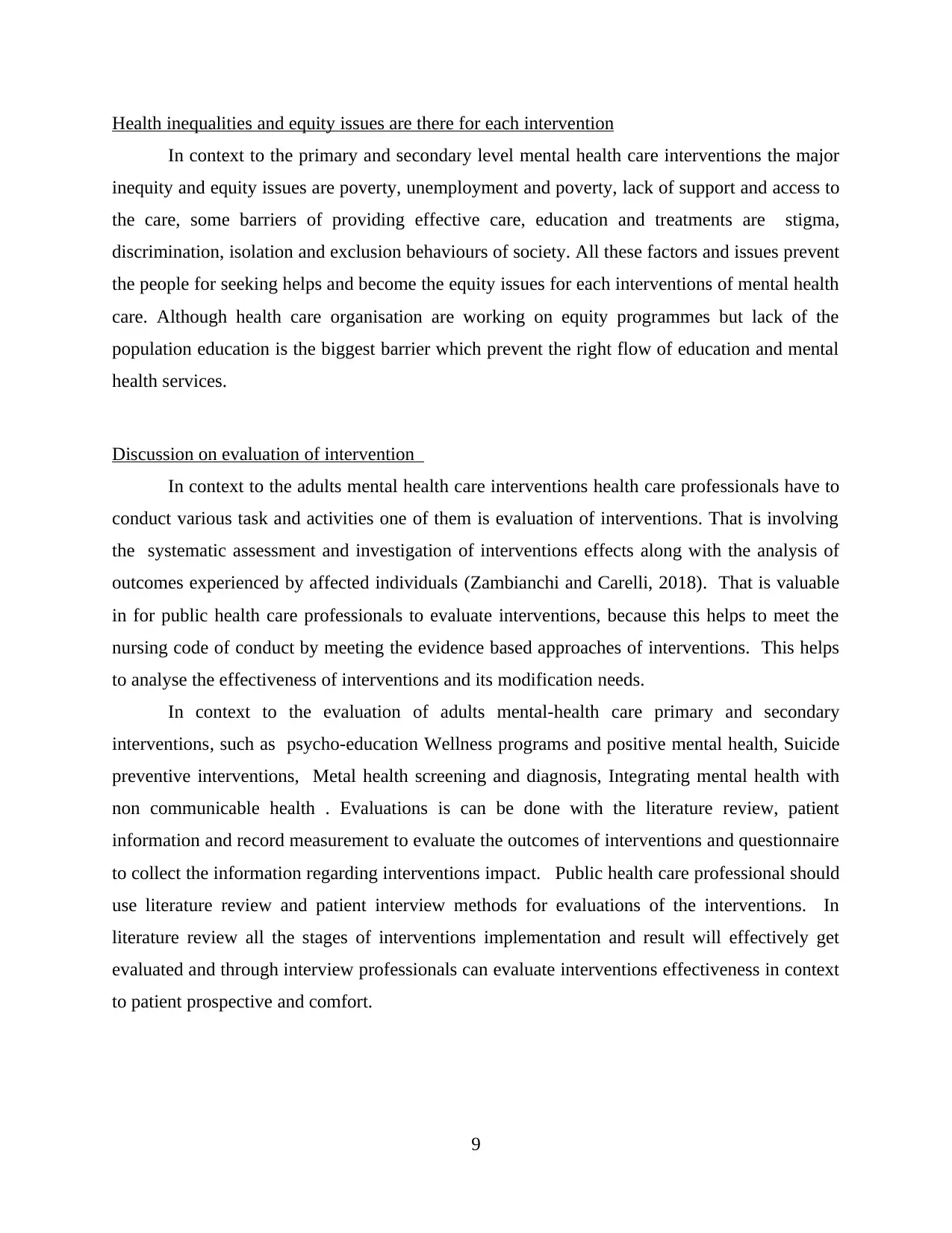
Health inequalities and equity issues are there for each intervention
In context to the primary and secondary level mental health care interventions the major
inequity and equity issues are poverty, unemployment and poverty, lack of support and access to
the care, some barriers of providing effective care, education and treatments are stigma,
discrimination, isolation and exclusion behaviours of society. All these factors and issues prevent
the people for seeking helps and become the equity issues for each interventions of mental health
care. Although health care organisation are working on equity programmes but lack of the
population education is the biggest barrier which prevent the right flow of education and mental
health services.
Discussion on evaluation of intervention
In context to the adults mental health care interventions health care professionals have to
conduct various task and activities one of them is evaluation of interventions. That is involving
the systematic assessment and investigation of interventions effects along with the analysis of
outcomes experienced by affected individuals (Zambianchi and Carelli, 2018). That is valuable
in for public health care professionals to evaluate interventions, because this helps to meet the
nursing code of conduct by meeting the evidence based approaches of interventions. This helps
to analyse the effectiveness of interventions and its modification needs.
In context to the evaluation of adults mental-health care primary and secondary
interventions, such as psycho-education Wellness programs and positive mental health, Suicide
preventive interventions, Metal health screening and diagnosis, Integrating mental health with
non communicable health . Evaluations is can be done with the literature review, patient
information and record measurement to evaluate the outcomes of interventions and questionnaire
to collect the information regarding interventions impact. Public health care professional should
use literature review and patient interview methods for evaluations of the interventions. In
literature review all the stages of interventions implementation and result will effectively get
evaluated and through interview professionals can evaluate interventions effectiveness in context
to patient prospective and comfort.
9
In context to the primary and secondary level mental health care interventions the major
inequity and equity issues are poverty, unemployment and poverty, lack of support and access to
the care, some barriers of providing effective care, education and treatments are stigma,
discrimination, isolation and exclusion behaviours of society. All these factors and issues prevent
the people for seeking helps and become the equity issues for each interventions of mental health
care. Although health care organisation are working on equity programmes but lack of the
population education is the biggest barrier which prevent the right flow of education and mental
health services.
Discussion on evaluation of intervention
In context to the adults mental health care interventions health care professionals have to
conduct various task and activities one of them is evaluation of interventions. That is involving
the systematic assessment and investigation of interventions effects along with the analysis of
outcomes experienced by affected individuals (Zambianchi and Carelli, 2018). That is valuable
in for public health care professionals to evaluate interventions, because this helps to meet the
nursing code of conduct by meeting the evidence based approaches of interventions. This helps
to analyse the effectiveness of interventions and its modification needs.
In context to the evaluation of adults mental-health care primary and secondary
interventions, such as psycho-education Wellness programs and positive mental health, Suicide
preventive interventions, Metal health screening and diagnosis, Integrating mental health with
non communicable health . Evaluations is can be done with the literature review, patient
information and record measurement to evaluate the outcomes of interventions and questionnaire
to collect the information regarding interventions impact. Public health care professional should
use literature review and patient interview methods for evaluations of the interventions. In
literature review all the stages of interventions implementation and result will effectively get
evaluated and through interview professionals can evaluate interventions effectiveness in context
to patient prospective and comfort.
9
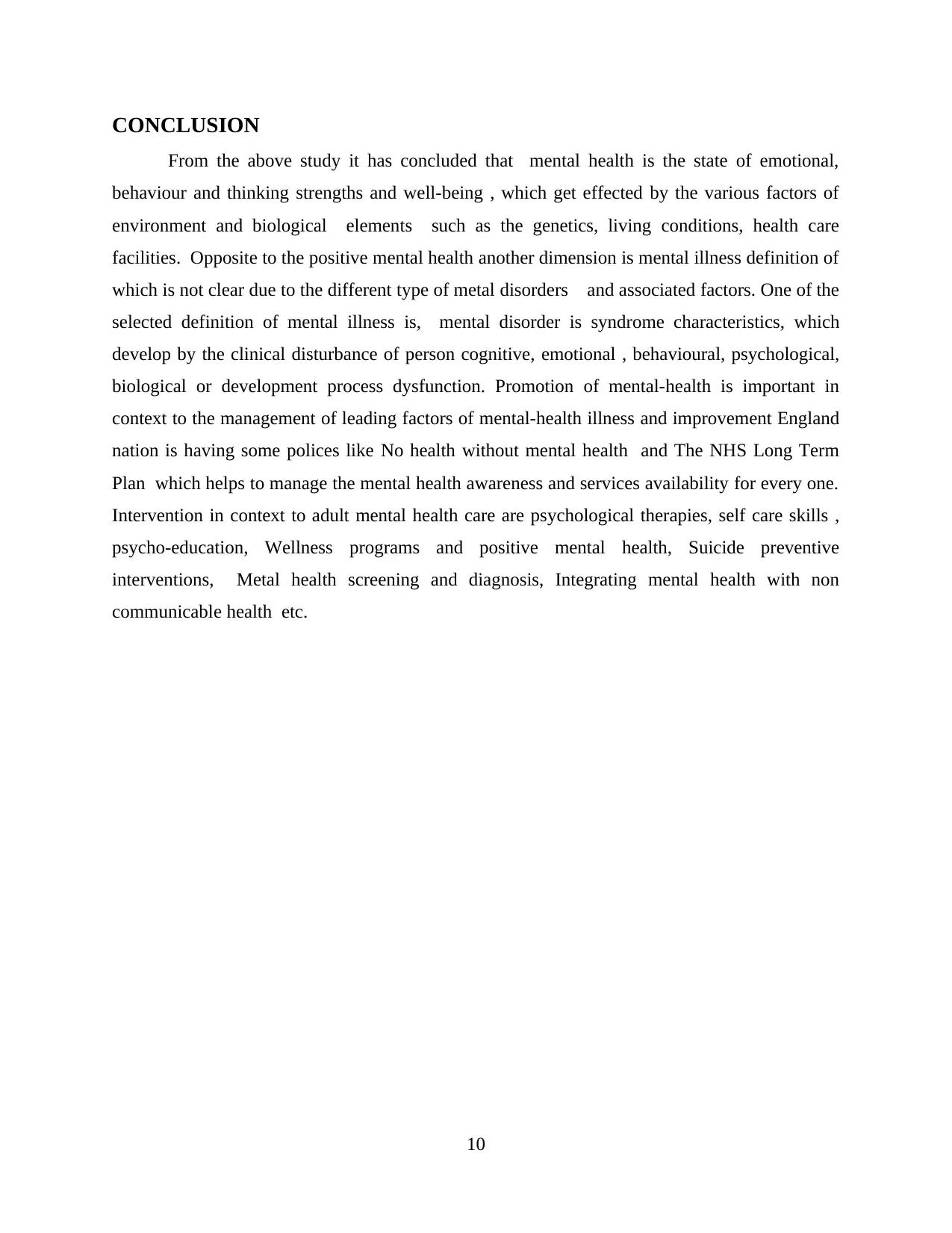
CONCLUSION
From the above study it has concluded that mental health is the state of emotional,
behaviour and thinking strengths and well-being , which get effected by the various factors of
environment and biological elements such as the genetics, living conditions, health care
facilities. Opposite to the positive mental health another dimension is mental illness definition of
which is not clear due to the different type of metal disorders and associated factors. One of the
selected definition of mental illness is, mental disorder is syndrome characteristics, which
develop by the clinical disturbance of person cognitive, emotional , behavioural, psychological,
biological or development process dysfunction. Promotion of mental-health is important in
context to the management of leading factors of mental-health illness and improvement England
nation is having some polices like No health without mental health and The NHS Long Term
Plan which helps to manage the mental health awareness and services availability for every one.
Intervention in context to adult mental health care are psychological therapies, self care skills ,
psycho-education, Wellness programs and positive mental health, Suicide preventive
interventions, Metal health screening and diagnosis, Integrating mental health with non
communicable health etc.
10
From the above study it has concluded that mental health is the state of emotional,
behaviour and thinking strengths and well-being , which get effected by the various factors of
environment and biological elements such as the genetics, living conditions, health care
facilities. Opposite to the positive mental health another dimension is mental illness definition of
which is not clear due to the different type of metal disorders and associated factors. One of the
selected definition of mental illness is, mental disorder is syndrome characteristics, which
develop by the clinical disturbance of person cognitive, emotional , behavioural, psychological,
biological or development process dysfunction. Promotion of mental-health is important in
context to the management of leading factors of mental-health illness and improvement England
nation is having some polices like No health without mental health and The NHS Long Term
Plan which helps to manage the mental health awareness and services availability for every one.
Intervention in context to adult mental health care are psychological therapies, self care skills ,
psycho-education, Wellness programs and positive mental health, Suicide preventive
interventions, Metal health screening and diagnosis, Integrating mental health with non
communicable health etc.
10
Paraphrase This Document
Need a fresh take? Get an instant paraphrase of this document with our AI Paraphraser
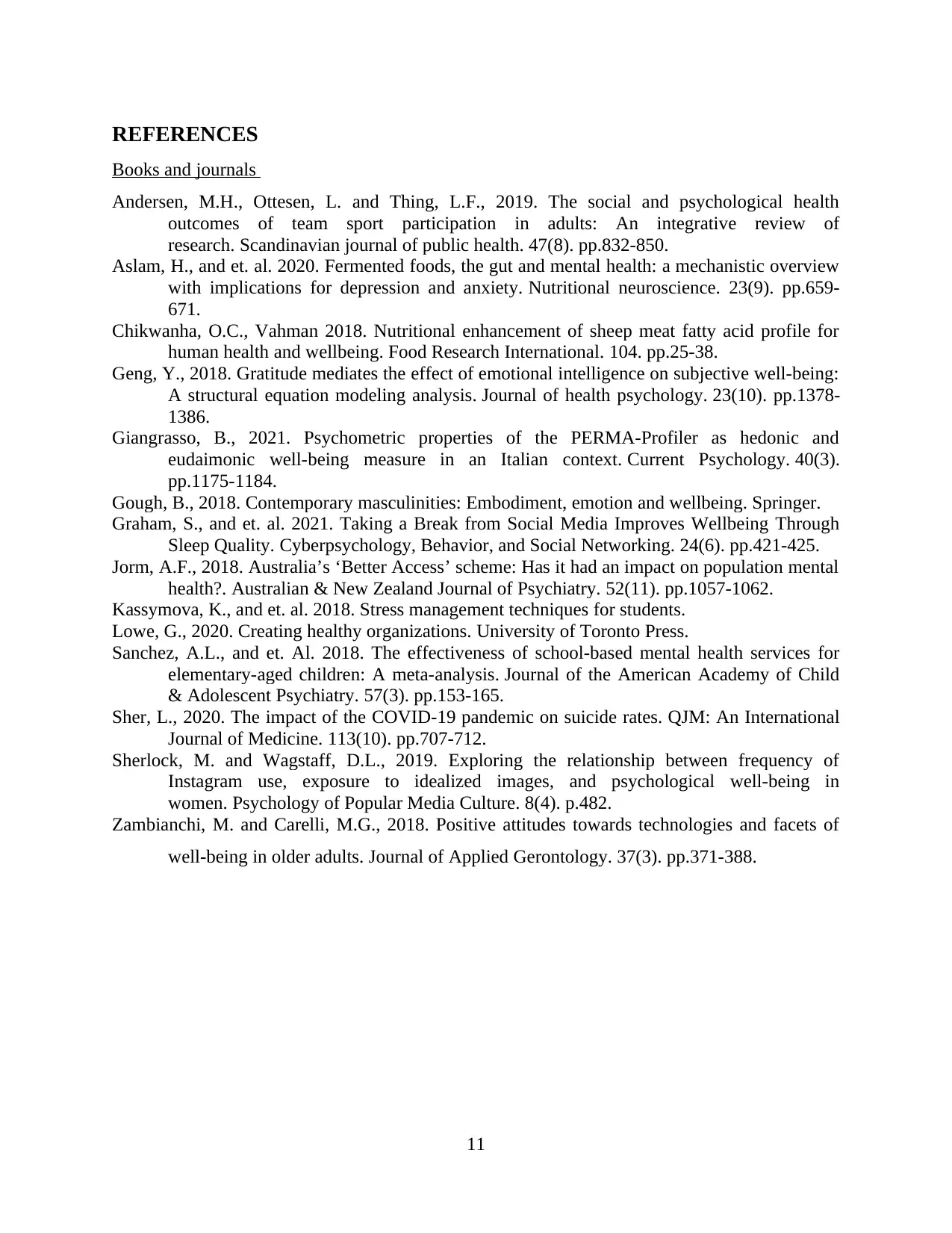
REFERENCES
Books and journals
Andersen, M.H., Ottesen, L. and Thing, L.F., 2019. The social and psychological health
outcomes of team sport participation in adults: An integrative review of
research. Scandinavian journal of public health. 47(8). pp.832-850.
Aslam, H., and et. al. 2020. Fermented foods, the gut and mental health: a mechanistic overview
with implications for depression and anxiety. Nutritional neuroscience. 23(9). pp.659-
671.
Chikwanha, O.C., Vahman 2018. Nutritional enhancement of sheep meat fatty acid profile for
human health and wellbeing. Food Research International. 104. pp.25-38.
Geng, Y., 2018. Gratitude mediates the effect of emotional intelligence on subjective well-being:
A structural equation modeling analysis. Journal of health psychology. 23(10). pp.1378-
1386.
Giangrasso, B., 2021. Psychometric properties of the PERMA-Profiler as hedonic and
eudaimonic well-being measure in an Italian context. Current Psychology. 40(3).
pp.1175-1184.
Gough, B., 2018. Contemporary masculinities: Embodiment, emotion and wellbeing. Springer.
Graham, S., and et. al. 2021. Taking a Break from Social Media Improves Wellbeing Through
Sleep Quality. Cyberpsychology, Behavior, and Social Networking. 24(6). pp.421-425.
Jorm, A.F., 2018. Australia’s ‘Better Access’ scheme: Has it had an impact on population mental
health?. Australian & New Zealand Journal of Psychiatry. 52(11). pp.1057-1062.
Kassymova, K., and et. al. 2018. Stress management techniques for students.
Lowe, G., 2020. Creating healthy organizations. University of Toronto Press.
Sanchez, A.L., and et. Al. 2018. The effectiveness of school-based mental health services for
elementary-aged children: A meta-analysis. Journal of the American Academy of Child
& Adolescent Psychiatry. 57(3). pp.153-165.
Sher, L., 2020. The impact of the COVID-19 pandemic on suicide rates. QJM: An International
Journal of Medicine. 113(10). pp.707-712.
Sherlock, M. and Wagstaff, D.L., 2019. Exploring the relationship between frequency of
Instagram use, exposure to idealized images, and psychological well-being in
women. Psychology of Popular Media Culture. 8(4). p.482.
Zambianchi, M. and Carelli, M.G., 2018. Positive attitudes towards technologies and facets of
well-being in older adults. Journal of Applied Gerontology. 37(3). pp.371-388.
11
Books and journals
Andersen, M.H., Ottesen, L. and Thing, L.F., 2019. The social and psychological health
outcomes of team sport participation in adults: An integrative review of
research. Scandinavian journal of public health. 47(8). pp.832-850.
Aslam, H., and et. al. 2020. Fermented foods, the gut and mental health: a mechanistic overview
with implications for depression and anxiety. Nutritional neuroscience. 23(9). pp.659-
671.
Chikwanha, O.C., Vahman 2018. Nutritional enhancement of sheep meat fatty acid profile for
human health and wellbeing. Food Research International. 104. pp.25-38.
Geng, Y., 2018. Gratitude mediates the effect of emotional intelligence on subjective well-being:
A structural equation modeling analysis. Journal of health psychology. 23(10). pp.1378-
1386.
Giangrasso, B., 2021. Psychometric properties of the PERMA-Profiler as hedonic and
eudaimonic well-being measure in an Italian context. Current Psychology. 40(3).
pp.1175-1184.
Gough, B., 2018. Contemporary masculinities: Embodiment, emotion and wellbeing. Springer.
Graham, S., and et. al. 2021. Taking a Break from Social Media Improves Wellbeing Through
Sleep Quality. Cyberpsychology, Behavior, and Social Networking. 24(6). pp.421-425.
Jorm, A.F., 2018. Australia’s ‘Better Access’ scheme: Has it had an impact on population mental
health?. Australian & New Zealand Journal of Psychiatry. 52(11). pp.1057-1062.
Kassymova, K., and et. al. 2018. Stress management techniques for students.
Lowe, G., 2020. Creating healthy organizations. University of Toronto Press.
Sanchez, A.L., and et. Al. 2018. The effectiveness of school-based mental health services for
elementary-aged children: A meta-analysis. Journal of the American Academy of Child
& Adolescent Psychiatry. 57(3). pp.153-165.
Sher, L., 2020. The impact of the COVID-19 pandemic on suicide rates. QJM: An International
Journal of Medicine. 113(10). pp.707-712.
Sherlock, M. and Wagstaff, D.L., 2019. Exploring the relationship between frequency of
Instagram use, exposure to idealized images, and psychological well-being in
women. Psychology of Popular Media Culture. 8(4). p.482.
Zambianchi, M. and Carelli, M.G., 2018. Positive attitudes towards technologies and facets of
well-being in older adults. Journal of Applied Gerontology. 37(3). pp.371-388.
11
1 out of 14
Related Documents
Your All-in-One AI-Powered Toolkit for Academic Success.
+13062052269
info@desklib.com
Available 24*7 on WhatsApp / Email
![[object Object]](/_next/static/media/star-bottom.7253800d.svg)
Unlock your academic potential
© 2024 | Zucol Services PVT LTD | All rights reserved.





